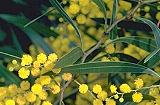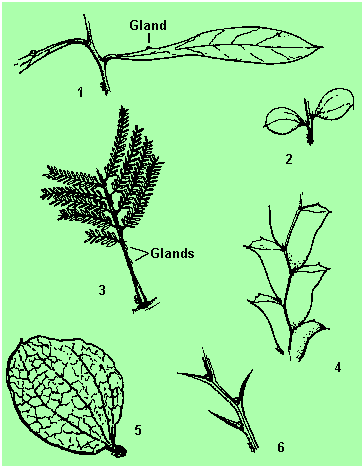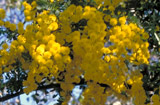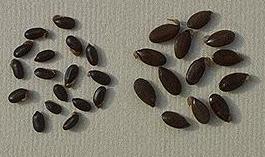|
[Front Page] [Features] [Departments] [Society Home] [Subscribe]

Acacia - An Introduction
Marion Simmons
Based on the text of a talk given at the General Meeting of the Northern Group (Australian Plants Society - Tasmania) on 15 June 1999.
Acacias, together with peas and sennas, belong in the family Mimosaceae. They occur on most continents as well as Australia and islands to the north. Australia has the greatest number of acacias with well over 1100 species described so far with a lot more still to come. They occur over a wide area of the continent and, with the eucalypts, provide the dominant vegetative cover.
The name Acacia is derived from the Greek word 'akis' meaning "a sharp point" and relates to the sharp thorned species of tropical Africa and Western Asia that were the only known acacias at the time that the name was published.
How do we recognise an Acacia? This can be difficult. If there are ball or spike flowers or normal pods on the bush then it is easy, but if only prickly leaves are present it is very easy to make a mistake....it may be a pea! The leaves can give a clue if you know what to look for. The presence of parallel or penni-nerves or a gland on the margin perhaps. Some pods on the bush or on the ground might help. Prickly peas often have tiny pods, but not always. To be sure you really do need the flowers!
Acacias vary immensely in size and shape from tiny prostrate plants to small shrubs, medium shrubs and of course to trees, some of them up to 30 or 40 metres tall. Acacia melanoxylon or A.bakeri are a good examples. Some, like A.peuce, live for up to 1000 years. And there are two climbers! They occur in tropical Queensland, one of which A.pennata ssp.kerrii, a bipinnate leave liane, has sharp prickles on the stems that enable it to climb up through the tropical forest for about 15 metres and send trailing feathery-leaved stems above the tree line.
 |
A distinctive feature of Acacia macradenia is the zig-zag shape of the stems between leaf nodes.
Select the thumbnail image or highlighted name for a higher resolution image (46k). Photo: Keith Townsend
|
Acacias often occur as colonisers of disturbed land, or after fire. Acacia dealbata comes up in the thousands at such times. They have a life span varying from a few up to about thirty years and play an important role in preparing the soil for the longer-lived trees. Acacias fix nitrogen in the soil through the activity of a soil bacterium that inhabits, and forms nodules on their roots. Thus acacias are important components of any woodland.
Bark
Bark is sometimes eye-catching and a good means of identification. Some species, especially in northern Australia, have unusual "minni-ritchi" or "cat scratch" bark that curls back in tiny pieces, often revealing a red underlay. Some species have deeply furrowed bark, called 'ironbark', as in A. excelsa, or corky bark. Acacia bidwillii is one of several bipinnate-leaved species with corky bark. However, the majority of species have grey smooth or rough bark not likely to attract attention.
Leaf types
 
Phyllodes and Leaves
- 1 and 2: Phyllodes of different shapes
- 3: Fern-like (bipinnate foliage)
- 4: Winged stems, the only foliage on some species
- 5; A phyllode showing net-veins
- 6: Phyllodes are reduced to spines on some species
Acacias are divided into two major leaf types although there are other minor divisions. The majority of our acacias have what appear to be leaves. These are, in fact, flattened or modified leaf stems called "phyllodes" that have evolved to take the place of leaves and, by their construction, are believed to help minimise water loss in hot climates. The other type has bipinnate or fern-like leaves such as A.mearnsii, one of several "black wattles". Bipinnate-leaved species, it is understood, mostly occur in higher rainfall areas.
 
If acacias are grown from seed, the first leaves to emerge are true leaves and, unless they are going to be bipinnate as adults, will soon develop phyllodes. Several species maintain their true leaves until they are about one metre tall. You may have seen A.melanoxylon revert to juvenile leaves when damaged in some way.
Nerves
If you look closely at the phyllodes you will notice the venation differs in individuals; some have single central nerves, some have several nerves (like A.verniciflua), others have a few-to-many longitudinal parallel nerves and those like the elephant-ear wattle (A.dunnii) have veins running into the lower margin. Some species, for example the northern A.retivenia, display a fine network of veins called anastomoses. There are many variations to be found.
Glands
The majority of species have glands or extrafloral nectaries as they are sometimes called. I wonder if you have ever noticed them? Sometimes they are hard to find as they are embedded in the leafstalk or pulvinus. In others they are really conspicuous and usually occur along the top margin. Some like A.bancroftii and A.wardellii of Queensland have very prominent glands indeed. Others differ and there are several that have glands under the tip of the phyllode and one, A blakelyi in Western Australia, that has a gland on the central margin that makes it very easy to identify.
On the bipinnate species, the glands usually occur on the main leaf stalk often where the pairs of pinnae meet, but sometimes in between the pinnae, as on A.mearnsii. On A.dealbata, the silver wattle, they occur only at the junction of the pinnae - a tip to remember to easily separate the two.
Flowers
Acacias are most conspicuous when in flower. Flowerheads, whether balls or spikes (some of which may be up to 10 cm long) consist of a number of tiny perfect flowers which are visible if you look at them in bud. These vary from two or three in each head. as in A.myrtifolia, up to more than a hundred in A.anceps of South Australia. Flowers occur on single stalks, in clusters, on racemes (as on A.dealbata) or as panicles, which are branched racemes.
 |
Acacia spectabilis, Mudgee wattle, (top) and Acacia leptostachya, Townsville wattle, (bottom) show the two typical arrangements of Acacia flowerheads.
Select the thumbnail image or highlighted name for a higher resolution image (45k and 31k).
Photo of A.leptostachya: Keith Townsend
|  |
Colour
The predominant flower colour is yellow— but there are many shades of yellow! Colour can vary from white/cream and lemon yellow, right through gold to a brilliant orange yellow. An unusual mauve-flowered prostrate species, A.purpureapetala, occurs in Queensland and in Western Australia there are several species with purplish red buds and stems. A few years ago we heard of a brilliant red-flowered Acacia identified as A.Ieprosa from Victoria. I understand that the original plant has died but that cuttings from have struck and hopefully are still growing in the Melbourne Botanic Gardens.
Pods
At the right time, pods may be a feature and often are a good means identification. The variety of shape and texture is surprising.
Growing acacias
 
The usual way of growing acacias from seed is by first soaking the seed in near boiling water and leaving it overnight (see photo....untreated seed on left; soaked seed on right). Alternatively, if only a few seeds are to be sown, the seed case can be "nicked" with a long sharp needle or blade (taking care not to damage the inner part of the seed) and then sow in the normal way.
The phyllodinous acacias are quite successfully grown from cuttings and, if you want to grow more of a favourite plant, this is the only way to go.
Unfortunately, hybridisation takes place in our gardens so you can't rely on the seed coming true to type from that source.
The ferny leaved species appear to be much more difficult to strike as the tiny leaflets tend to fall off quickly and the cutting soon dies.
Acacias overseas
For some years certain species of Acacia, usually from dry zones of northern Australia, have been selected for plantation trials in Asia, Africa and India. Some have shown good potential as a food source, or fuelwood or for environmental protection - all urgently needed characteristics in famine-prone countries where plant cover has been removed. Special regard is paid to selecting the provenance to match the climate and soils of the trial area. Species selection criteria include:
- known to be used in Aboriginal diets:
- low toxic and anti-nutritional factors, and high nutritional value seeds compared with local species;
- easy and quick to establish:
- rapid early growth:
- heavy early seed production.
Some of our acacias that meet these criteria are A.colei, A.coriacea and A.Iigulata, but many more are under trial.
Acacias as food
Traditionally Australian Aborigines used many native plants and still do in a minor way. Much is being written on "bush food" as interest in it grows. However, where acacias are concerned, most published information refers to mainland dry-area species. A fairly new publication. "Edible Wattle Seeds of Southern Australia", gives useful information on a number of species (see "Australian Plants", March 1999 for further information).
A small but growing industry is using wattle seeds in a variety of foods, including biscuits, ice cream and chocolate. Most seeds are harvested from the wild by Aboriginal and some commercial collectors, although commercial cultivation of wattles for this purposes is being actively investigated.
The average protein content of Acacia seed is between 17 and 27 per cent, higher than other grains such as wheat (10 to 12%). Some species are known to have a high proportion of polyunsaturated fats and may be suitable for oilseed production.
But Caution!!
Little is known of the levels of anti-nutritional or toxic components in the seeds of temperate Australian acacias, so using them as a food source should be approached with caution. Accurate identification and research are essential before trying them out. Those commonly used by the Aborigines should prove to have low toxicity although experts consider further testing and study advisable as inhibitors, which prevent protein breakdown, are often present. These inhibitors are mostly de-activated by cooking.
A common method of preparation was to roast mature seed, grind it into flour, mix with water and cook as a damper. Some specific seeds were eaten raw but most were roasted, often in their pods, before eating.
In a 'Plants of Tasmania Nursery' publication some Tasmanian species are listed as being suitable for use. Hobart Group member Kris Schaffer is keenly interested in the topic and a member of the ASGAP's Australian Food Plant Study Group, and has compiled the information on the subject. The acacias she mentions are A.mucronata, A.verniciflua, A.verticillata, A.melanoxylon, A.dealbata and A.sophorae. It is widely reported that A.sophorae seeds were cooked in the pods and eaten by Tasmanian Aborigines. However, a warning is given in the publication that the information was obtained from a number of references and, although passed on in good faith, extreme caution is advised as some plants can have both poisonous and edible parts;
Since birds and animals rely on native plants for food (especially the fruits and berries) readers are reminded to harvest lightly from the wild or to grow their own plants.
Further information may be obtained from the magazine, "Australian Bush Foods" - this may not be widely available but the magazine has a web site. Another site, Bush Tucker Supply, has information and recipes (such as wattleseed ice cream).
From "Eucryphia", newsletter of the Australian Plants Society (Tasmania), September 1999.
Marion Simmons is a former leader of the Society's Acacia Study Group and author of several books on the genus.

[Front Page] [Features] [Departments] [Society Home] [Subscribe]
Australian Plants online - December 1999
Association of Societies for Growing Australian Plants
|